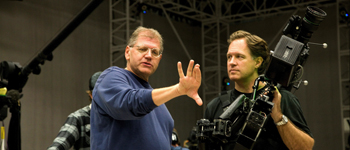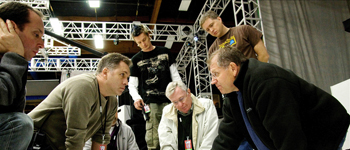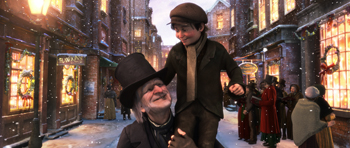
CJ Powers is an author/speaker
residing in the Chicagoland area. As a Writer/Director/Producer he
is an international script consultant and conducts screenwriting
workshops. His films released internationally and television programs
aired on CBS, PBS, ABC, the Family Channel, and various syndicated
stations. The majority of CJ’s directing awards, including the Silver
CINDY and Crystal Communicator of Excellence, were for family films. He
received additional honors from the U.S. and International Film and
Video Festival and the New York Film Festival. He is a guest writer for
Christianity Today’s
Singles Connection eNewsletter and has also been an Arts &
Entertainment columnist for the DuPage Christian.
|
Brainstorming New Story Ideas |
|
“Old Marely was as dead as a doornail.” If you’ve been around the block a few times, you no doubt know Charles Dickens’s The Christmas Carol in detail. It is a story that many say has been overdone on the silver screen. And yet, one of my favorite directors, Robert Zemeckis, noted for his films Back to the Future, Forest Gump, and The Polar Express, decided to take on the project.  For the story to work, Zemeckis had to find a new angle to grab and keep the audience’s attention. With his penchant for time travel, he decided to address the film from the perspective of historical accuracy, including the still under construction Big Ben. To that end, his team researched old maps, artwork, and written descriptions of the city. They even had wardrobe shipped in from London’s Victoria and Albert Museum to gain a better understanding of the times and culture.  The result was a movie that brought in $30 million in its opening weekend and was instantly raised into the top 20 Christmas films of all time. However, it wasn’t the only story that was reinvented to capture a new audience. Zemeckis’s Who Framed Roger Rabbit? had the same successful story beats as did Chinatown. In fact, if you watch the movies back-to-back, you’ll be amazed at the similarity. Yet, the average person would never draw that conclusion because of the artistic and creative treatment given to Zemeckis’s combined live action and animated film. Suffice it to say that a new perspective creates a new and unique view on a story and allows you to explore things that haven’t yet been considered. All it takes is a new perspective.  I was part of a Bell Labs innovation session, similar to a think tank. The idea was to put a group of mixed creative types into a room and have them brainstorm the company’s future into existence. To warm up, we were all given a do-hickey or thingamajig and told to determine how it could be used. The assignment was to write down one hundred ideas. After the first ten minutes, most of my colleagues and I had a dozen ideas reduced to writing. A half hour later, we all had thirteen to seventeen ideas down. Some of us quickly ascertained that it might take days to figure out a hundred uses for the object. The next half hour of effort was boring, and most of our brains shut down—and to think this was just the warm-up exercise. Then relief came. The creative guide got everyone’s attention and suggested that we face the same opportunity from the perspective of a small child. Within ten minutes I had an additional twenty-three ideas written down. At that moment, my grandmother popped into my mind, so I considered her vantage point and wrote down an additional twenty-two ideas. Next, I used the dog’s perspective, then my sister’s, and then the green one-eyed camel’s perspective. My creativity was soaring and I found well over one hundred uses and wrote them on my paper.  |
Creative brainstorming is not a new venture for most filmmakers. Walt Disney was one of the best in his pursuit to transform all the Brothers Grimm stories into monumental pictures for the entire family. In fact, to help facilitate the brainstorming process, Walt created what today is known as Displayed Thinking—a process to help creative artists and technical experts communicate ideas. Though
times have changed the
terminologies and altered or refined the systems, most creative
thinking elements include: For those who do not work in teams, this system can still work by changing your personal viewpoints several times during the creative process. While I’m not suggesting that a split personality is a good idea, choosing different people’s perspectives to address the ideas bring about broader viewpoints and more ideas for consideration. The successful brainstorming session is the one that accepts all ideas but doesn’t keep them all. The attitude must be one of acceptance, not putting down or discouraging any creative thought no matter how wild. The natural process will force the participants to focus more and more on the better ideas, leaving the remainder for the archival folder to be developed later or used in future sessions.  Disney Parks used some thirty-year-old ideas when it created Disney France. Hong Kong Disneyland had to create a new story for the Haunted Mansion because the perspective of the afterlife is significantly different for the Chinese. By considering a new perspective, Disney was able to learn that the ride needed to be about the supernatural or mystical powers, giving rise to the Mystic Mansion.  Zemeckis brought a new creative perspective to an age-old story in order to pump new cinematic life into it. Taking advantage of technology, Zemeckis fitted Jim Carrey into a performance-capture body suit complete with electrodes and a helmetcam. This gave him the power to visualize Ebenezer’s flights through historically accurate cityscapes, to take advantage of Carrey’s talent in playing seven characters, and to give the audience a unique perspective by creatively positioning the camera in places never possible before—creating an incredible juxtaposition of visuals and story.  Article Copyright © 2009 by
CJ Powers CJ Powers can be reached for script consultation and translation work at cjpowers7[at]gmail [dot] com. |







